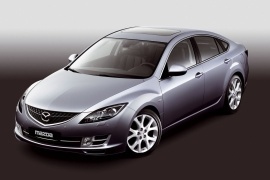
MAZDA 6 / Atenza Hatchback
Generations Timeline, Specs and Pictures

The second generation of the Mazda 6/Atenza has followed Ford’s ideas regarding the body shapes, and it was offered as a sedan, hatchback, and station wagon.
Ford owned a big chunk of Mazda since 1996, and as part of the plan was sharing platforms and engines between the brands. That’s why the Mazda 6 received the Mondeo’s platform, and it was a good move. The Japanese carmaker was known for its sporty products, starting whit the best-selling roadster globally, the MX5, and the only sports car on the market with a rotary engine, the RX8. The 6 tried to offer a pleasant, sporty feeling for a family sedan.
Mazda designers decided to combine curved lines and sharp angles. The front wheel-arches were enlarged, and the swept-back headlights evoked the samurai warrior eyes. Its sweeping, V-shaped pentagonal grille enhanced the sporty look of the vehicle. Despite being taller, wider, and longer than its predecessor, it was lighter by 35 kg (77.2 lbs). The five-door hatchback featured a sloped tailgate.
The interior was large and comfortable for four adult passengers. While the front bucket seats featured average-height bolstering, the split-folding bench in the back was profiled for two occupants. Depending on the trim level, Mazda installed a Bose sound system and a sat-nav.
Under the hood, Mazda installed a wide range of engines. For starters, a 1.8-liter was considered good enough, mostly for fleet use. Depending on the market, the 6 offered a Ford-sourced 2.0-liter turbodiesel. Due to its independent suspension in all corners, it offered good handling and comfort.

The 2002 Mazda 6/Atenza came on the market as a replacement for the former 626 model, which was based on the same platform with the compact 323 model.
Mazda came on the market well prepared for all kinds of customers. The 6 was available as a sedan, hatchback, and station wagon. It followed the same recipe used by Opel for the Vectra and by Ford for the Mondeo. Unlike its blue-oval sibling, the 6/Atenza featured a bolder design and a sportier image. The hatchback version had a sportier look since it was designed more like a fastback than a regular hatchback.
While the carmaker had its hands full with customers who had to decide between a sedan and a station wagon, it still tried to give the market a hatchback. Thanks to its standard bucket seats, the 6/Atenza was appreciated for its comfort, while the high-bolstering was good for holding its occupants in place during hard cornering. In the rear, Mazda installed a split-folding bench that could expand the trunk space.
The 2002 Mazda6’s platform was used for more vehicles within the Ford Motor Company. At that time, Mazda was in a partnership with the American company. Ford Edge, Lincoln MKX, and Zephyr or the CX9 SUV from Mazda were built on the same architecture, with an all-wheel independent suspension.
Most of the Mazda6s had front-wheel-drive. Engines varied from a 1.8-liter with 125 hp up to 220 hp from a 3.0-liter V6 in some markets. The transmissions offered were either five or six-speed manuals. For the automatic versions, there were four or five speeds transmissions available, depending on the engine.























































